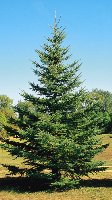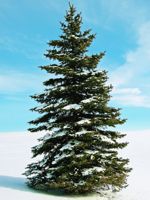Mon-Fri 9am - 5pm Mountain time
White Spruce vs Black Hills Spruce
Picea glauca var. densata
Picea glauca
Black Hills Spruce is a subspecies of White Spruce native to the Black Hills of South Dakota. It has a strongly conical form, slower growth rate and denser foliage than typical white spruce, making it preferable as a specimen tree for smaller suburban lawns. It also responds well to pruning, and can be used as a hedge or even bonsai.
White Spruce is a hardy, long-lived evergreen tree. It can grow in many soil types and moisture levels. And it can even tolerate significant amounts of shade. White spruce requires little maintenance and is well suited for use in shelterbelts, privacy screens, hedges, and as an ornamental in an urban setting.
Black Hills Spruce Quick Facts
White Spruce Quick Facts
In row spacing: 3 - 4 m (10 - 12 ft)
In row spacing: 3 m (10 ft)

